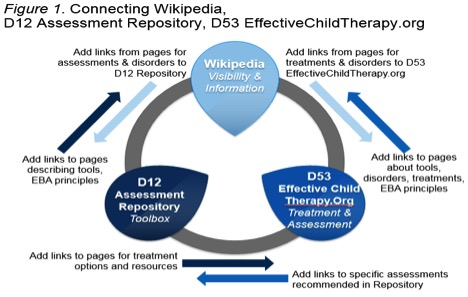Division 12, in collaboration with Division 53, is embarking on a new initiative that will increase public knowledge of and accessibility to evidence-based assessment resources. The initiative is partially funded by the APA inter-divisional grant program. Evidence-based assessment (EBA) has advanced greatly in the past two decades. Current barriers to EBA include cost, accessibility, and lack of consumer knowledge about what is available. The primary goal of the initiative is to utilize Wikipedia to increase accessibility to EBA resources, and to link to enhanced resources on the Division 12 and 53 websites.
Using Beidas et al.’s (2015) criteria for evaluating standardized instruments – adapted from Hunsley and Marsh (2005; 2007), the team will create a template evaluation to be used to appraise measures identified for possible inclusion. Wikipedia ‘edit-a-thons’ will be facilitated to edit or create Wikipedia pages for included measures, with links to assessment and treatment resources on the Division 12 and 53 sites. In turn, Wikipedia links will be added to these resources. This will undoubtedly guide more traffic to these pages and hopefully will increase public access to these valuable resources.
The Division 12 assessment repository will be searchable based on domains measured, population age, informant, language, and type. When possible measures will be made available for download on the site.

Goals
The goal of this project is to use Wikipedia to increase the accessibility and availability of information about evidence-based assessment (EBA), synergizing and leveraging existing resources and initiatives from Divisions 53 and 12 of the APA. Outcomes will include more links between resources, more hits per resource, and more students and early career psychologists actively engaged with the divisions.
Specific Aims, Mechanisms, and Measurable Outcomes:
Aim 1. Add new, free evidence-based assessment instruments to the D12 Assessment Repository
1.1. Identify new evidence-based assessment methods
1.2. Contact authors for permission to access and store electronic copies of measures
Aim 2. Expand the information available online about evidence-based assessment
2.1. Create template Wikipedia file for EBA article about each measure
2.2. Add sample articles
2.3. Engage people by doing Edit-a-Thons
Aim 3. Connect D12 Assessment Repository, EffectiveChildTherapy.Org (EfChTx.org), and Wikipedia
Wikipedia provides a unique opportunity to address these maintenance and visibility challenges. According to Alexa.com, Wikipedia is the 7th most visited Internet site in the world. Number 1 is Google.com; and Wikipedia enjoys a special relationship with Google, where Wikipedia pages are boosted to appear high on the list of search results. In contrast, the D12 web page is currently ranked 696,784 globally, 196,042 in the USA, and EffectiveChildTherapy.Org is ranked 1,462,677 globally, 199,465 in the USA (searches done May 12, 2015). The EBA resources are not yet visible enough for consumers and clinicians to find them quickly.
Connecting these sites with Wikipedia would put the information and resources where consumers–and often practitioners–are looking first, rather than trying to grow traffic incrementally at existing specialty sites. APS and other professional societies have advocated engaging with Wikipedia (Farzan & Kraut, 2013), but progress has been limited by the need to learn some HTML coding in able to make significant edits. D53 has invested in hiring a Wikipedia Campus Ambassador to develop a set of template pages, instructional checklists for editing, and brief online videos to help people learn to add evidence-based psychological content to Wikipedia. Engaging Wikipedia to increase the visibility of evidence-based psychological practice is the D53 presidential initiative for 2016.
This initiative creates a window of opportunity to integrate both divisional projects with Wikipedia, raising their visibility tremendously. This would combine “direct to consumer” marketing (Becker, Spirito, & Vanmali, 2015) with teaching the public about the distinct value of psychological assessment and psychological services in general (Farzan & Kraut, 2013). It also would multiply the impact of the existing divisional investments in creating the websites and online repositories.
Project Team
Division 53
Eric Youngstrom, PhD
Amanda Jensen-Doss, PhD
Rinad Beidas, PhD
Division 12
Damion Grasso, PhD
Evan Forman, PhD
Interested in Contributing to this Initiative?
CONTACT US to be involved in this initiative and/or to suggest inclusion of a measure
References
Becker, S. J., Spirito, A., & Vanmali, R. (2015). Perceptions of ‘Evidence-Based Practice’ among the consumers of adolescent substance use treatment. Health Education Journal. doi: 10.1177/0017896915581061
Beidas, R. S., Stewart, R. E., Walsh, L., Lucas, S., Downey, M. M., Jackson, K., . . . Mandell, D. S. (2015). Free, brief, and validated: Standardized instruments for low-resource mental health settings. Cogn Behav Pract, 22(1), 5-19. doi: 10.1016/j.cbpra.2014.02.002
Farzan, R., & Kraut, R. E. (2013). Wikipedia classroom experiment: bidirectional benefits of students’ engagement in online production communities. Paper presented at the Proceedings of the SIGCHI Conference on Human Factors in Computing Systems.
Hunsley, J., & Mash, E. J. (2005). Introduction to the special section on developing guidelines for the evidence-based assessment (EBA) of adult disorders. Psychological Assessment, 17(3), 251-255. doi: 10.1037/1040-3590.17.3.251
Hunsley, J., & Mash, E. J. (2007). Evidence-based assessment. Annual review of clinical psychology, 3, 29-51. doi: 10.1146/annurev.clinpsy.3.022806.091419
